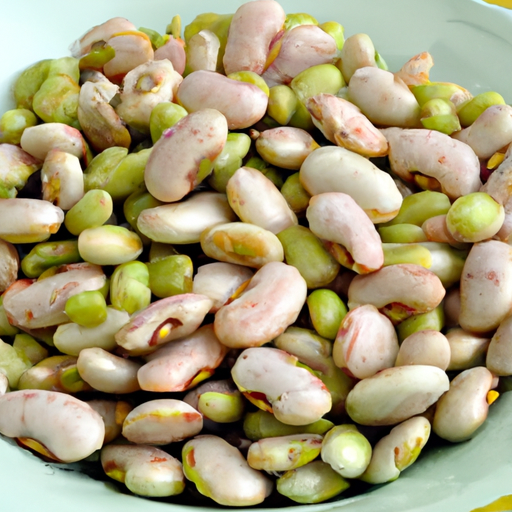Exploring the Versatility of Lima Beans: A Nutritious and Delicious Ingredient
Image Source: Unsplash.com
Lima beans, also known as butter beans, are a humble legume that often gets overlooked in the culinary world. But don’t let their unassuming appearance fool you! These small, creamy gems pack a punch when it comes to taste, nutrition, and versatility in the kitchen. In this article, we’ll explore the many aspects of lima beans, from their delightful flavor to their extensive history and culinary uses.
Unveiling the Flavor Profile
Lima beans possess a delicate, buttery flavor that pairs well with a wide variety of ingredients and spices. Their smooth, creamy texture adds a comforting element to any dish. When cooked properly, lima beans become tender and slightly nutty, making them a wonderful addition to soups, stews, and salads. They have a mild taste that readily absorbs the flavors of herbs, spices, and seasonings, making them an ideal canvas for experimentation in the kitchen.
Timeless Culinary Applications
Cultures across the globe have embraced lima beans as a staple ingredient in their traditional cuisines. In Mediterranean cuisine, lima beans are often featured in succulent casseroles, while in Latin American cooking, they take center stage in hearty soups and stews like the popular Brazilian “Feijoada.” In the Southern United States, lima beans are often cooked with ham hocks or bacon to create a comforting and hearty side dish.
Nutritional Powerhouse
Lima beans are not only delicious but also pack a nutritious punch, making them an excellent addition to any well-balanced diet. They are an excellent source of plant-based protein, providing a substantial amount of amino acids necessary for building and repairing body tissues. Additionally, lima beans are rich in dietary fiber, aiding in digestion and promoting a healthy gut. They also contain an array of essential vitamins and minerals, including folate, magnesium, potassium, and iron. Including lima beans in your meals can bolster your nutritional intake while satisfying your taste buds.
A Historical Perspective
The roots of lima beans can be traced back thousands of years to their origin in Peru, where they were first cultivated by the indigenous people of the region. These legumes were then spread throughout the Americas by Spanish explorers during the colonial era. Over time, lima beans became a crucial part of traditional cuisines, gracing tables and enriching dishes with their distinct texture and flavor. Today, they continue to be loved and appreciated by many, standing as a testament to the enduring legacy of our culinary history.
Fun Facts about Lima Beans
- Lima beans are part of the larger legume family, which includes beans, lentils, and peanuts.
- They are available in two main varieties: the larger Fordhook variety and the smaller Baby Lima variety.
- Due to their buttery nature, lima beans were named after Lima, the capital city of Peru.
- Dry lima beans have an extended shelf life, making them an affordable and convenient ingredient for long-term storage.
Next time you encounter lima beans, don’t shy away from their unassuming appearance. Embrace the opportunity to explore their vast culinary potential. Whether you blend them into a creamy dip, incorporate them into a vibrant salad, or simmer them in a comforting soup, lima beans are sure to add depth and flavor to your creations, all while nurturing your body with their impressive nutritional profile. So go ahead, let these versatile legumes ignite your imagination in the kitchen!
Remember to soak dry lima beans overnight before cooking to shorten the cooking time and enhance their tenderness.
Interesting Facts about Lima Beans:
Origin: Lima beans, also known as butter beans, have been cultivated for thousands of years and are believed to have originated from the Andes region of South America.
Common Uses: Lima beans are valued for their creamy texture and nutty flavor. They are commonly used in both savory and sweet dishes around the world. They can be added to soups, stews, salads, and casseroles, or made into dips, spreads, and even desserts.
Nutritional Benefits: Lima beans are a nutritious food, rich in fiber, protein, and various vitamins and minerals. They are a good source of folate, manganese, iron, potassium, and magnesium. They also provide antioxidants and are low in fat and cholesterol.
Unique Properties: Lima beans are known for their distinctive buttery flavor and delicate texture. They have a starchy composition that lends itself well to thickening soups and sauces. Lima beans are also well-suited for canning and freezing, which allows them to be enjoyed year-round.
Historical Significance: Lima beans have a long history and have been a staple crop in many cultures. They were introduced to Europe by Spanish explorers in the 16th century and later spread to other parts of the world through trade routes. Lima beans were widely cultivated by Native American tribes in North America, such as the Hopi and Navajo, who have incorporated them into their traditional cuisines for centuries.
Varieties: There are different varieties of lima beans, including both bush and pole varieties. Bush lima beans grow in a compact manner and mature earlier, making them suitable for smaller gardens. Pole lima beans grow on climbing vines and require support. Some popular varieties include Fordhook, Henderson, and King of the Garden.
Allergies and Precautions: While lima beans are considered safe for most people, it’s important to note that some individuals may have allergies to legumes, including lima beans. If you have a known legume allergy, it is advisable to avoid lima beans and related products.
Scientific Name: The scientific name for lima bean is Phaseolus lunatus. It belongs to the legume family, Fabaceae.
Remember to always cook lima beans properly, as raw or undercooked beans can contain a naturally occurring toxin called linamarin, which can be harmful if consumed in large quantities.




Use the share button below if you liked it.
It makes me smile, when I see it.